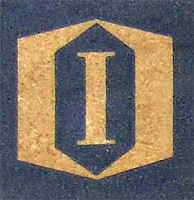
Intermetall, founded in Düsseldorf in 1952, was one of the first German semiconductor companies. The history of this important but relatively little-known company is documented on several Web sites, notably the excellent radiomuseum. I summarise it here.
The company logo, printed on their devices, is a capital I inside a hexagon as shown on the right. Crucially, Herbert Franz Mataré was its founder chief scientist. He had previously invented the transistor independently of Bell Labs at his former employer, Westinghouse Freins & Signaux in France (NO connection with Westinghouse Electric in the USA). He therefore knew the technology needed for production of germanium point-contact transistors, but his research interest was in 'intermetallic' compounds (ie III-V compound semiconductors), which led to the name of the company. He recruited former Westinghouse staff to develop this interest but it was ultimately to fail commercially.
The company started, like many others, by manufacturing germanium point-contact diodes. They then moved on, like many others, to germanium point-contact transistors, which Mataré already knew how to manufacture. In August 1953 at the Düsseldorf Radio Fair the company demonstrated the first ever publicly exhibited working transistor radio, using point-contact transistors. However this was a prototype and was not commercialised.
Further series of diodes and transistors were produced, but research continued into III-V compound semiconductors. This was not commercially successful and Intermetall was purchased in 1955 by Clevite Transistor Products, an American company that by then was specialising in power transistors. Mataré left the company at this point. Clevite did not have a range of low-power junction transistors, and Intermetall was able to fill that gap with newly-developed germanium types.
These were exhibited at the Dusseldorf 'Deutsche Funkausstellung' exhibition in 1955, but a lower-key innovation was more significant: Intermetall had moved on to silicon devices in the form of junction diodes. (They also showed Clevite germanium power transistors, and germanium power rectifiers using JEDEC part numbers, probably manufactured by GE in the USA). By late 1956 Intermetall had a wide range of silicon low-power junction transistors. Both diodes and transistors were also sold under the Brush Crystal Company branding owned by Clevite.
I have Intermetall and Brush data catalogues which include Clevite transistors: 2N series medium- and high-power types and CTP series high-power devices, germanium and silicon. I assume that these were manufactured in the USA and so I do not include any here. Intermetall (and Brush) only manufactured lower-powered transistors.
Intermetall went on to develop innovative silicon diodes and transistors but in 1965 it was sold by Clevite to ITT. This is probably the point at which my own historical interest ceases, but the company continued and exploited synergy with other ITT subsidiaries. In 1997 it was purchased by the Swiss Micronas Group and became Micronas Intermetall. In 2015 Micronas was acquired by the TDK Corporation and renamed to TDK-Micronas.
I am seeking to buy or trade for some germanium (and silicon) transistors and diodes made by Intermetall. Details are given below. I also want to buy any original data books or sheets for any of their early semiconductor devices.
If you know about them, or have have some devices for sale or trade, please
Ich suche, die Germanium transistoren und Dioden zu kaufen, die von Intermetall hergestellt werden. Ich möchte auch ursprüngliche Leistungsblätter für sie kaufen. Wenn Sie in diesen Transistoren oder Dioden auskennen oder haben, einiges für Verkauf oder Handel zu haben, in Verbindung.

Intermetall's first products were the M series of germanium point-contact diodes in ceramic bodies:
These had axial bodies with a colour dependent upon the part number.
I am very interested in obtaining any of these diodes. If you know some that are for sale or trade, please
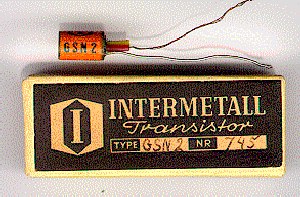
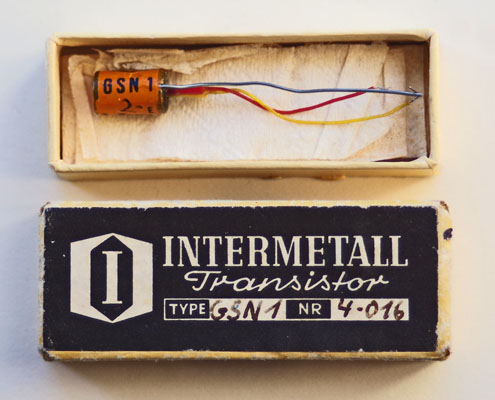
In 1953 Intermetall issued two germanium point-contact transistors, types GSN1 and GSN2. Initial versions are double-ended, but my images show later single-ended versions. They come in small cartons containing a sheet with handwritten characteristic data. In 1954 they went on to issue further point-contact types GSN3 to GSN6.
I am very interested in obtaining any of these transistors by Intermetall. If you know about Intermetall's earliest semiconductors, or have have some for sale or trade, please
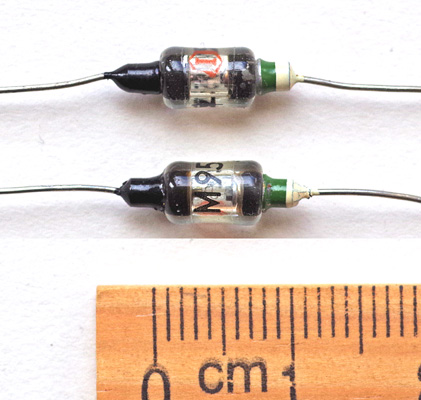
Also in 1954 they released a range of hermetically glass sealed diodes:
My image shows the M95. It has a rather unusual body that seems to consist of two glass tubes, one inside the other, or possibly just one very thick tube. It is printed M95 and bears the Intermetall logo in red. One lead is colour-coded white-green for 95 in the electronic colour code. These rare devices came from the collection of J.H.J. Hodes, Voorburg, The Netherlands. I would be interested to obtain other members of the series. If you know where I might find any, please

In early 1955 Intermetall started production of germanium junction transistors. The first of these were:
These come in a TO-22 oval outline.
I am very interested in obtaining any of these transistors by Intermetall. If you know about them, or have have some for sale or trade, please
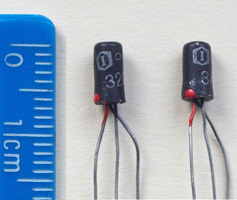
At the same time Intermetall issued lower-power miniature versions of these transistors in a TO-2 outline (PNP types only):
My image shows the OC320 and OC340.
I am interested in obtaining examples of the OC330. If you know where some are for sale or trade, please
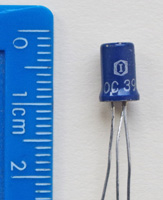
They made a single germanium transistor for AM broadcast IF amplifier applications: OC390. It was shown at the Dusseldorf 'Deutsche Funkausstellung' Exhibition in August-September 1955 along with the above AF types.

At the Dusseldorf Exhibition in 1955 Intermetall also showed the Clevite power transistors:
The X-125 looks a bit like a tall TO-3 outline with three leads, the other two use extravagant finned heatsinks.
I am seeking all three, branded Clevite or Intermetall, so if you know about them, or have have some for sale or trade, please
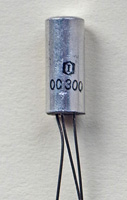
I do not know when production started, but Intermetall made a series of germanium transistors OC300 to OC309, plus OC318. OC303 onwards are listed in the booklet 'Intermetall Halbleiter Bauelemente' dated June 1962.
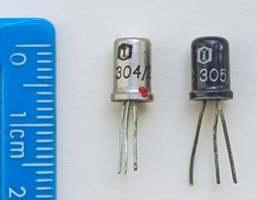
The SO-2 usage is interesting. The Philips group companies enclosed a glass envelope transistor in a metal sheath. Intermetall did not use the glass envelope, instead the SO-2 can is either directly bonded to the transistor 'header', or else it is fitted over a smaller metal can.
I am looking for original data for OC300 to OC302. I am also interested in obtaining examples of OC301 and OC302. If you know where some are for sale or trade, please
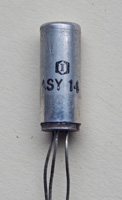
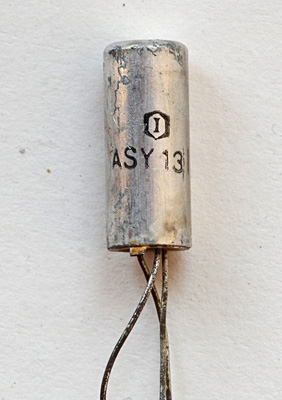
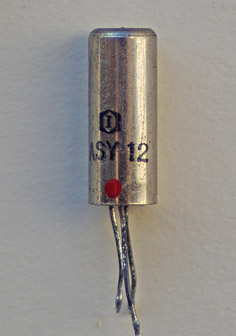
Intermetall Halbleiter 1962 also lists germanium PNP switching transistors ASY12, ASY13 and ASY14 in the Philips-style SO-2 metal outline (but without a glass capsule inside). These possibly have versions with suffix I, II or 2.
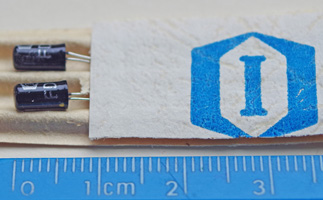
I have some Intermetall diodes type FD3. Intermetall Halbleiter 1962 specifies the series FD3 to FD7 as germanium general-purpose diodes. I do not know when production started.
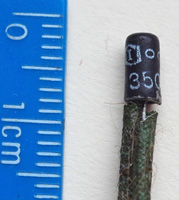
Intermetall made a whole series of germanium transistors intended for hearing aids, some in a miniature can:
The only ones I have are the OC350 (shown) and the OC360. I would be interested in samples of the others but I suspect that they are rare. I do not know of any German hearing aids that used them.
The above seems like a comprehensive product set, but I suspect that many of the apparently different devices were frequency- and/or gain-selected from the same production line. This was common practice.
Wide as this range of germanium types was, it was in silicon that Intermetall really made its mark.
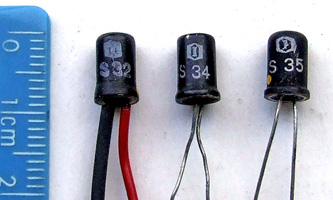
Their first silicon products were the junction diodes S21, S22, S23 and S24 released at the Dusseldorf Exhibition. Within a few months these diodes were replaced by a technically superior series: the S32, S33, S34, and S35. Later, a type S36 was added. My image shows three of these types.
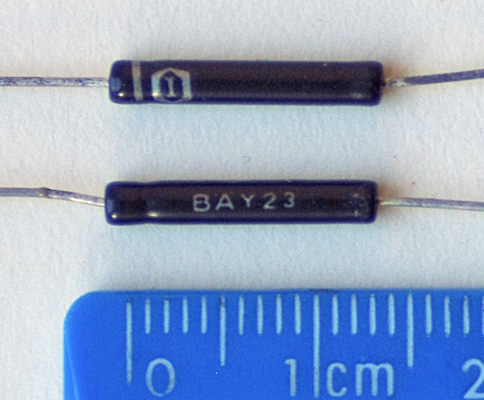
In the same section as these S3x diodes, the Intermetall Halbleiter booklet from 1962 also lists four silicon diodes using Pro-electron nomenclature:
and it goes on to list four high-voltage silicon diodes:
My image shows the Intermetall BAY23 in a rather long axial glass outline. You can find later unbranded versions in more standard shapes.
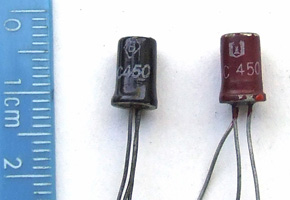
In August 1956 Intermetall were advertising silicon transistors, the first German company to do so. They had a range in TO-1A cans:
My image shows two examples of OC450, one branded Intermetall, the other with the B in the diamond that signifies Brush Crystal Company, now renamed Brush-Clevite. Clevite, the owners of Intermetall, also owned this brand, but I am uncertain what its use signifies. Possibly Brush sold rebranded Intermetall devices to the UK market. If you can explain this, please
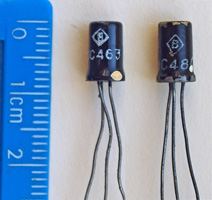
Intermetall Halbleiter 1962 extends the range, and specifies that these were transistors 'for high or sustained temperatures'. This clearly emphasises the temperature tolerance of silicon over germanium.
My upper image on the right shows an OC463 and an OC480, both with Brush Clevite branding rather than Intermetall.
I have few of these types. If you have have some for sale or trade, please
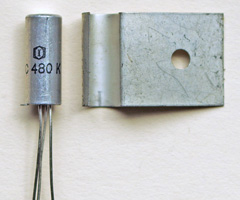
The K suffix stands for 'Kühlkörper' which means 'heatsink'. For other German transistors this usually means that they are clamped in an aluminium block. This is not the case for Intermetall devices, for the Halbleiter booklet shows that the K versions use the larger SO-2 metal encapsulation, plus a heatsink metal fin. The lower right image shows an OC480K with its fin.
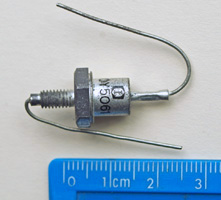
Intermetall Halbleiter shows three ranges of silicon power diodes:
My image shows OY5061. This is GDR nomenclature, so perhaps they were intended for that market.
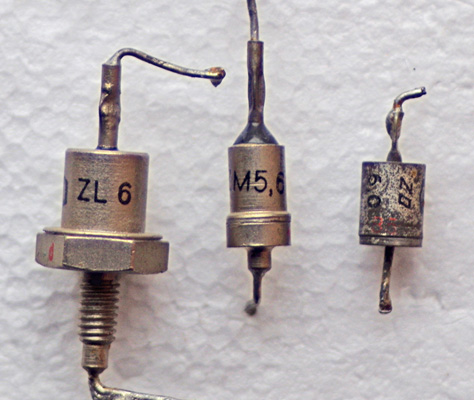
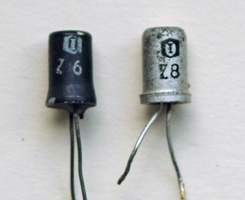
Intermetall and Brush issued a surprising number of ranges of silicon Zener diodes. These include:
Many of these series had many members following either the E12 or E24 number series. The image on the right shows the Z6 and Z8. I do not have many examples of the other series.
As with most manufacturers, I have several Intermetall devices that don't appear in my data books or on the Web. These are:
If you have data for any of these, please